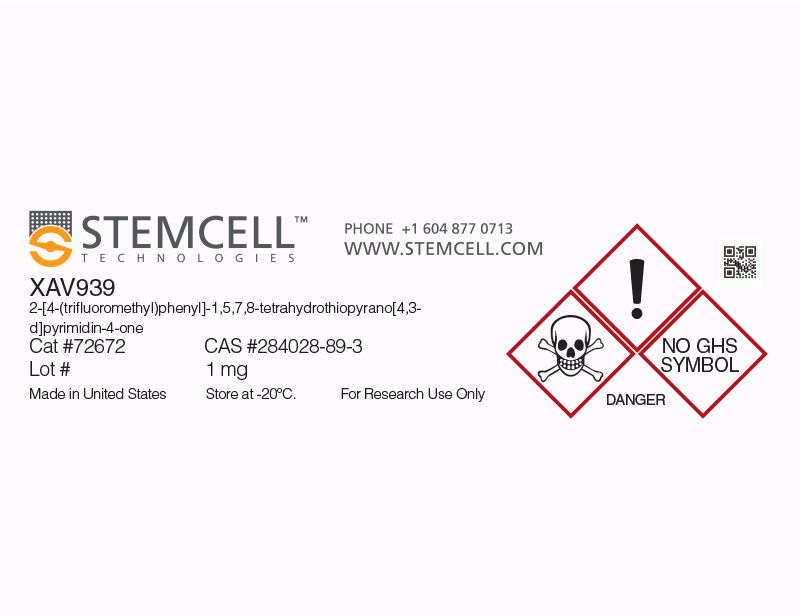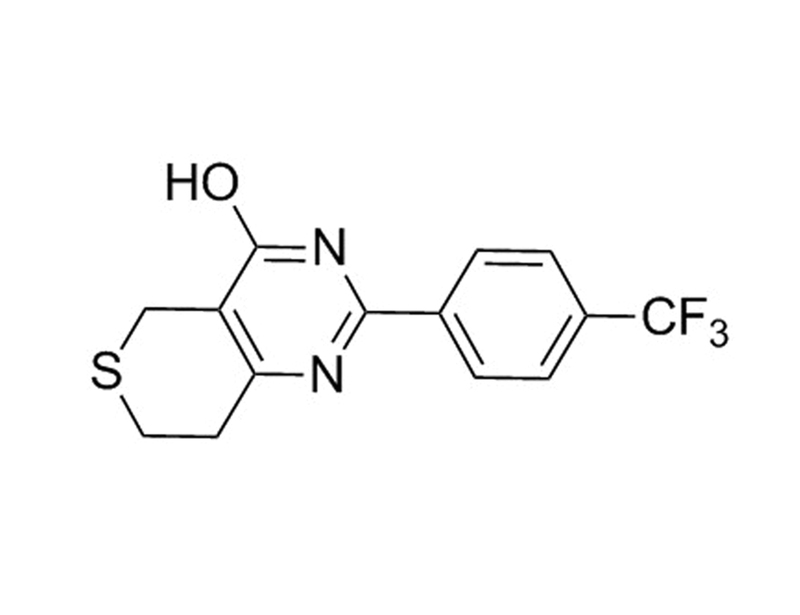概要
XAV939 is a potent, small molecule inhibitor of tankyrase (TNKS) 1 and 2 (IC₅₀ = 11 and 4 nM, respectively) (Huang et al.). By inhibiting TNKS activity, XAV939 increases the protein levels of the axin-GSK3β complex and promotes the degradation of β-catenin in SW480 cells (Huang et al.), thereby inhibiting WNT pathway downstream actions.
DIFFERENTIATION
· Induces cardiomyogenesis in mesoderm progenitor cells derived from mouse embryonic stem cells (Wang et al.).
· In combination with the SMAD inhibitors LDN193189 and SB431542, promotes induction of forebrain fates in human pluripotent stem cell lines (Maroof et al.).
CANCER RESEARCH
· Inhibits colony formation of APC-deficient, β-catenin-dependent DLD-1 colorectal cancer cells (Huang et al.).
DIFFERENTIATION
· Induces cardiomyogenesis in mesoderm progenitor cells derived from mouse embryonic stem cells (Wang et al.).
· In combination with the SMAD inhibitors LDN193189 and SB431542, promotes induction of forebrain fates in human pluripotent stem cell lines (Maroof et al.).
CANCER RESEARCH
· Inhibits colony formation of APC-deficient, β-catenin-dependent DLD-1 colorectal cancer cells (Huang et al.).
技术资料
| Document Type | 产品名称 | Catalog # | Lot # | 语言 |
|---|---|---|---|---|
| Product Information Sheet | XAV939 | 72672, 72674 | All | English |
| Safety Data Sheet | XAV939 | 72672, 72674 | All | English |
数据及文献
Publications (7)
Cell stem cell 2013 MAY
Directed differentiation and functional maturation of cortical interneurons from human embryonic stem cells.
Abstract
Abstract
Human pluripotent stem cells are a powerful tool for modeling brain development and disease. The human cortex is composed of two major neuronal populations: projection neurons and local interneurons. Cortical interneurons comprise a diverse class of cell types expressing the neurotransmitter GABA. Dysfunction of cortical interneurons has been implicated in neuropsychiatric diseases, including schizophrenia, autism, and epilepsy. Here, we demonstrate the highly efficient derivation of human cortical interneurons in an NKX2.1::GFP human embryonic stem cell reporter line. Manipulating the timing of SHH activation yields three distinct GFP+ populations with specific transcriptional profiles, neurotransmitter phenotypes, and migratory behaviors. Further differentiation in a murine cortical environment yields parvalbumin- and somatostatin-expressing neurons that exhibit synaptic inputs and electrophysiological properties of cortical interneurons. Our study defines the signals sufficient for modeling human ventral forebrain development in vitro and lays the foundation for studying cortical interneuron involvement in human disease pathology.
ACS chemical biology 2011 MAR
Cardiac induction of embryonic stem cells by a small molecule inhibitor of Wnt/β-catenin signaling.
Abstract
Abstract
In vitro differentiation of embryonic stem cells is tightly regulated by the same key signaling pathways that control pattern formation during embryogenesis. Small molecules that selectively target these developmental pathways, including Wnt, and BMP signaling may be valuable for directing differentiation of pluripotent stem cells toward many desired tissue types, but to date only few such compounds have been shown to promote cardiac differentiation. Here, we show that XAV939, a recently discovered small molecule inhibitor of Wnt/β-catenin signaling, can robustly induce cardiomyogenesis in mouse ES cells. Our results suggest that a timely administration of XAV939 immediately following the formation of mesoderm progenitor cells promotes cardiomyogenic development at the expense of other mesoderm derived lineages, including the endothelial, smooth muscle, and hematopoietic lineages. Given the critical role that Wnt/β-catenin signaling plays in many aspects of embryogenesis and tissue regeneration, XAV939 is a valuable chemical probe to dissect in vitro differentiation of stem cells and to explore their regenerative potential in a variety of contexts.
Nature 2009 OCT
Tankyrase inhibition stabilizes axin and antagonizes Wnt signalling.
Abstract
Abstract
The stability of the Wnt pathway transcription factor beta-catenin is tightly regulated by the multi-subunit destruction complex. Deregulated Wnt pathway activity has been implicated in many cancers, making this pathway an attractive target for anticancer therapies. However, the development of targeted Wnt pathway inhibitors has been hampered by the limited number of pathway components that are amenable to small molecule inhibition. Here, we used a chemical genetic screen to identify a small molecule, XAV939, which selectively inhibits beta-catenin-mediated transcription. XAV939 stimulates beta-catenin degradation by stabilizing axin, the concentration-limiting component of the destruction complex. Using a quantitative chemical proteomic approach, we discovered that XAV939 stabilizes axin by inhibiting the poly-ADP-ribosylating enzymes tankyrase 1 and tankyrase 2. Both tankyrase isoforms interact with a highly conserved domain of axin and stimulate its degradation through the ubiquitin-proteasome pathway. Thus, our study provides new mechanistic insights into the regulation of axin protein homeostasis and presents new avenues for targeted Wnt pathway therapies.
Cell 2006 NOV
Wnt/beta-catenin signaling in development and disease.
Abstract
Abstract
A remarkable interdisciplinary effort has unraveled the WNT (Wingless and INT-1) signal transduction cascade over the last two decades. Wnt genes encode small secreted proteins that are found in all animal genomes. Wnt signaling is involved in virtually every aspect of embryonic development and also controls homeostatic self-renewal in a number of adult tissues. Germline mutations in the Wnt pathway cause several hereditary diseases, and somatic mutations are associated with cancer of the intestine and a variety of other tissues.
Nature 2005 APR
Wnt signalling in stem cells and cancer.
Abstract
Abstract
The canonical Wnt cascade has emerged as a critical regulator of stem cells. In many tissues, activation of Wnt signalling has also been associated with cancer. This has raised the possibility that the tightly regulated self-renewal mediated by Wnt signalling in stem and progenitor cells is subverted in cancer cells to allow malignant proliferation. Insights gained from understanding how the Wnt pathway is integrally involved in both stem cell and cancer cell maintenance and growth in the intestinal, epidermal and haematopoietic systems may serve as a paradigm for understanding the dual nature of self-renewal signals.
Genes & development 2000 AUG
Wnt signaling and cancer.
Abstract

 网站首页
网站首页





